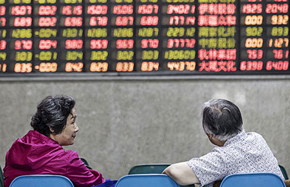Resilience and risks of Chinese economy in transformation
BEIJING - A year ago, economic forecasters at home and abroad bet on the sharp depreciation of the renminbi, or the yuan, in 2017 due to a flagging economy and US rate hikes. But the Chinese currency roaring back in past months has proven them wrong.
The yuan's midpoint saw a substantial increase to 6.6770 against the greenback Thursday, the strongest in more than 10 months, following a steady strengthening streak since the beginning of 2017. Onshore and offshore rates were also much firmer.
While curbed capital flight and the weaker US dollar were considered the immediate cause, the country's economic resilience played a fundamental role in propping up the currency.
China posted a forecast-beating GDP increase of 6.9 percent in the second quarter of the year despite expectations of a loss in momentum, flat with that of the January-March period. From buoyant factory activity to robust imports, latest indicators have disappointed doomsayers.
"Once again, the Chinese economy has defied the hand wringing of the nattering nabobs of negativism," Stephen Roach, faculty member at Yale University, wrote in an article on Project Syndicate.
Consumption power
Roach said deeper issues, namely reforms, were overlooked by pessimistic analysts. "The Chinese economy is in the midst of an extraordinary structural transformation - with a manufacturing-led producer model giving way to an increasingly powerful services-led consumer model."
The transition is being briskly pushed forward by China's middle class, a growing group generous in spending and fastidious in quality that will likely dominate the demographic structure in next decades.
Homi Kharas, now with the Brookings Institution, predicted in an OECD working paper that China will add 850 million to its middle class by 2030, which means the group will account for 73 percent of the population. In contrast, Europe will add only 16 million and North America will see a decline of 16 million.
The trend forecast by Kharas will reshape the landscape of both China and the world. "China will have a 9.7-trillion-dollar consumer market by 2030, the largest in the world," according to a lengthy report by Morgan Stanley, which predicted the world's second largest economy will become a high income country at that time.
The predicted picture is yet to come true, but preliminary effects have already been felt. Consumption contributed 63.4 percent of economic expansion in the first half (H1) of the year, outshining old engines of investment and exports.
Innovation-inspired miracle
Encouraged by robust domestic demand, Chinese companies, dissatisfied with churning out unprofitable, inferior small wares, are striving to climb up the industrial value chain to master the technology essential for creative, quality products.
The output of high-tech and equipment manufacturing rose 13.1 percent and 11.5 percent in H1, respectively, outpacing the 6.9-percent increase of the broader industry. Emerging sectors including new energy and new materials also picked up speed.
From high-speed trains to shared bicycles and mobile wallets, Chinese innovation is shaking up the global tech world and people's daily lives.
China moved up the list of the world's top 25 innovative economies, rising three notches from 25 to 22, according to a key innovation index jointly released in June by the World Intellectual Property Organization, Cornell University and INSEAD.
The country was top in a number of sub-rankings, including domestic market scale, human resources, patents by origin, high-tech exports, and industrial design by origin.
Despite a slower growth pace, the China miracle is not over but has entered its second phase focusing on consumption, technology and innovation, advanced manufacturing, and services, Michael Zakkour, China vice president at consulting firm Tompkins International, said in an article on Forbes.
Risks lingering
Despite bright prospects, risks are still looming for the economy in transformation.
Roach highlighted piling corporate debts and volatile home markets, and accordingly called for reforms in state firms and proper regulation over the property sectors including ensuring housing demand and restraining speculation.
Analysts also warned of risks from fiscal deficits and trade frictions with the United States.
Fully aware of the challenges, China's policy makers have rolled out a series of measures, reining in credit expansion and curbing overheated home purchases. Debt-ridden zombie companies are being dissolved and home markets are gradually back on track.
"Risks are generally controllable," Chinese Premier Li Keqiang said at the Annual Meeting of the New Champions 2017, or Summer Davos, in the city of Dalian. "We are capable of fending off all kinds of risks and ensuring the economic growth stays in a reasonable range."


















